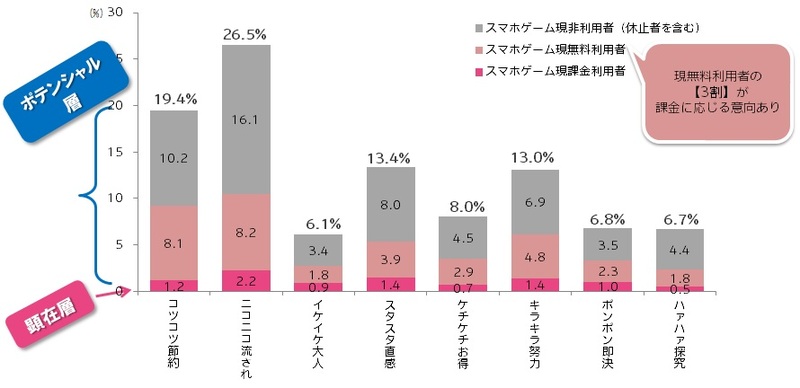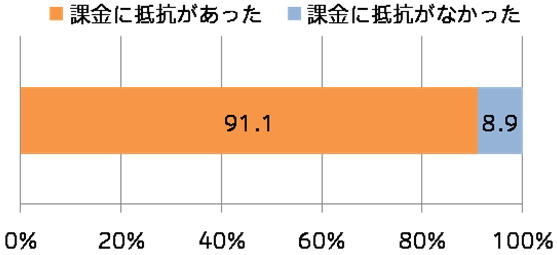Note: This website was automatically translated, so some terms or nuances may not be completely accurate.
What's the feeling behind spending money with a "tap" on smartphone games? (Part 2)
In the previous article, we explained that many people who initially felt negatively about in-app purchases in smartphone games come to view them positively once they have a clear personal reason for paying. This stems from the unique characteristics of smartphone games, which are particularly adept at satisfying "small desires." This time, we want to delve a little deeper into "the feeling of spending money on games."
1."Because of XX." The reasons for paying vary
When people spend money, the concept of "value for money" exists. We intuitively grasp the price range for goods and services beforehand: around 150-160 yen for a bottled drink, 300-400 yen for a beef bowl, or 500-800 yen for lunch. We judge whether it's "cheap," "fair," or "expensive" and pay money to obtain the goods or service as compensation.
Smartphone games, however, present a different challenge. When told "one item costs 100 yen," it's neither a tangible "good" nor a "service" received in the real world. This makes judging whether it's "cheap," "fair," or "expensive" quite difficult. Is 100 yen a fair price? It might actually feel expensive at ¥50, or cheap at ¥200. In other words, whether it's "worth ¥100" is left entirely to the consumer's judgment. It's a dilemma—is it really worth paying for? Yet, that little urge stirring inside wants to be satisfied. We struggle and agonize.
That's where the key phrase comes in: "Because it's ○○."
To judge whether spending on smartphone games is reasonable and to convince oneself, people look for comparable spending habits in their everyday lives. By thinking "Well, because...", they define the value of spending on smartphone games. "Well, I can just think of it as buying one dessert ♪" or "Well, I can just think of it as going to one drinking party with my senior ♪" – this way, they connect their own "reason" for paying money to the smartphone game with the "value" they get in return.
Recently, we conducted group interviews with people who make in-app purchases in smartphone games. The numerous "Because..." statements we observed were fascinating, each packed with unique reasons shaped by differing backgrounds like age, occupation, usual spending habits, and level of engagement with smartphone games.
The reasons for spending money on smartphone games are highly fragmented. That's precisely why Dentsu Inc. Smapla believes so many "Because... reasons" emerge in this space.
Additionally, consumers' reduced resistance to virtual currencies (non-cash currencies like credit cards, e-money, and carrier billing) is another factor making in-app purchases more accessible. With the spread of credit cards and electronic money, opportunities to handle physical cash like bills and coins are gradually decreasing. Consequently, paying with virtual currency for virtual "items" like smartphone game assets—a form that doesn't involve "paying with tangible money to receive tangible goods or services"—is likely being done without resistance, as a matter of course.
2.Analyzing human desires reveals 8 types of "Because..."
By cross-analyzing "General Desires" and "Financial Sensibilities," we can uncover the "Because...!" mindset driving in-app purchases on smartphones. Based on this approach, Dentsu Inc. Smart Plus created the "Smartphone Payment & Purchase Clusters."
[Figure 1] Smartphone Payment & Purchase Clusters

This revealed distinct characteristics in both the general desires experienced in daily life and the ways people enjoy smartphone games and make in-app purchases. These can be broadly classified into "8" types, each named a "○○ Consumer Segment".
For example, the "Go-Getter Adult Consumer Segment" consists of people who lead busy lives both on and off the clock. With strong consumption and achievement drives, they readily spend on smartphone games for reasons like "I want that rare item" or "I want to progress a bit further." Their rationale? "Because I don't have time." They have a strong desire to buy time with money. It's no surprise they spend the most on smartphone games among the eight clusters.
The "Sparkling Effort Consumer Group" is highly motivated to improve and spares no effort in self-improvement, while also being concerned about how others perceive them. Their keyword is "Because I want to be sparkling and fulfilled." They diligently put in the effort to keep shining brightly and don't hesitate to spend money to achieve that. In purchasing decisions, "cuteness" is a key criterion. For smartphone games, they'll pay for "visually cute" characters or decorative items to boost their mood or show off to friends. Of course, they also strongly desire to enhance their "inner self," actively leveling up and strengthening characters/items. This reflects their desire to be "wonderful inside and out," both personally and within the game.
Conversely, the "Haa Haa Exploration Consumers"—a group I also belong to—show high interest in games but little interest in broader societal trends. As expressed by the phrase "Well, as long as I'm happy," they are the type who "delve deeply into what they love." They invest significant time and money once they "get hooked," but it takes them a long time to reach that point. A defining characteristic is that if they deem something "boring" by their own standards, they lose all interest immediately. People in this segment show high interest in "entertainment content" itself—beyond smartphone games, including anime, manga, idols, and subculture—and spend considerable time and money on it. Consequently, their relative interest in smartphone games is lower. On average, they are less likely to make in-app purchases in smartphone games (ranking lowest among all 8 clusters).
Thus, the tendency is that those who actually spend money on smartphone games are more likely to be defined as "socially active" individuals, rather than those stereotypically labeled as "non-socially active" or "gamers."
3.The smartphone game market will continue to expand
Of course, there are still many people who use smartphone games but do not spend money, as well as those who do not play smartphone games at all.
[Figure 2] Percentage of Smartphone Game Paying vs. Free Users

Although nearly 90% of respondents initially reported a "negative attitude toward spending" ( see Figure 3, Series #02), it's highly likely that current free users, much like current paying users who now spend money and time on smartphone games, can overcome their resistance to spending—which they perceive negatively—by finding their own personal reason to justify it, such as "Well, because of XX." This suggests the smartphone game market still has significant room to grow.
[Figure 3] Resistance to Paying Among Current Paying Users

Japan, often called a gaming powerhouse, has a culture inherently receptive to video games. Personally, I climbed the steps of my youth alongside games throughout middle school, high school, and university. While how we play games—the platforms, playstyles, graphics quality, and payment methods—has evolved with the times, the fundamental desire to "have fun with games!!" has always been fulfilled, regardless of the changing forms.
And now, precisely because we can enjoy games anytime on our ever-present smartphones, we indulge those little urges—sometimes for free, sometimes by paying to enhance the experience. Before we know it, we find ourselves chatting more with friends about smartphone games. This seems like a phenomenon that wasn't common back when they were called "mobile games." As smartphone games become increasingly mainstream, they will continue to provide new entertainment and captivate more people.
Above all, games are simply fun! While there's that famous saying, "Only play games for one hour a day!", I hope they remain a wonderful form of entertainment that makes each day a little more enjoyable, as long as you find your own balance in time and money spent.
Next time, we'll step away from smartphone games a bit and explain the characteristics of smart devices like "PCs," "smartphones," and "tablets."
<About the Survey>
"Dentsu Inc. Smart Plaza Independent Survey on Smartphone Game Payments"
Survey Method: PC Internet Survey
Survey Period: Monday, May 12, 2014 - Friday, May 16, 2014
Target: Men and women aged 15–59 nationwide
Screening Survey: 18,000 samples
Main Survey: 3,000 samples
*The following three segments were each sampled with 1,000 respondents from the screening survey to obtain responses
1) Current smartphone game users (with paid usage)
2) Current smartphone game users (no in-app purchases)
3) Current non-users of smartphone games (including inactive users)

◎ What is "Dentsu Inc. Smartpla"?
It is a planning unit that contributes to the launch, growth, and expansion of businesses on smart devices (such as smartphones, PCs, and tablets).
Our team includes diverse professionals such as strategic planners, communication planners, consultants, copywriters, and producers, all with extensive experience in marketing communications for smartphone games and apps. Furthermore, as each member possesses a deep passion for specific subjects, we support marketing activities by not only delving deeply into challenges but also engaging clients with our unique personalities and human skills.
Was this article helpful?
Newsletter registration is here
We select and publish important news every day
For inquiries about this article
Back Numbers
Author

Yudai Iwai
Dentsu Inc.
First Integrated Solutions Bureau
Strategic Planner
Joined Dentsu Inc. in 2009. Since joining, has served as a Strategic Planner, responsible for developing marketing and communication strategies, product development, and consulting for diverse clients across industries including beverages, education, energy, web services, games, and real estate.